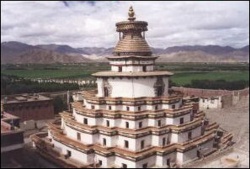Buddhist conference confirms Jonang as a separate school
DHARAMSHALA: Following years of research and deliberation, a high-level conference of Tibetan Buddhist practitioners and teachers confirmed the 11th century Jonang tradition as a major school of Tibetan Buddhism.
The endorsement came during the three-day 11th Buddhist conference held in Dharamshala last week which was attended by heads and representatives of the four major schools of Tibetan Buddhism and the ancient Tibetan religion of Bon.
The conference accorded the status of a separate sect to Jonang, noting its distinct philosophical stand-point and tradition within the ambit of Tibetan Buddhism.
His Holiness the Dalai Lama, while presiding over the meeting on the second day had urged the gathering of religious leaders to consider the Jonang issue “seriously.”
According to the north India based Jonang Takten Phuntsok Choeling Monastery, the Jonangpa tradition was founded in 1027 A.D. with a distinct philosophical viewpoint on the nature of reality.
The tradition was further systemized and promoted by Kunkhen Dolpopa Sherab Gyaltsen (1292-1361 A.D), the founder of the Middle-Way School of Extrinsic Emptiness of both Sutra and Tantra.
Kungpang Thugje Tsondue (1243-1313 A.D.), the first throne holder of the Jonang School, founded a monastery in Jomonang in U-tsang, and the monastery became known as the Jonangpa monastery.
Although the Jonang was considered to have been extinct since its 17th century demise in Central Tibet, recent findings had traced the existence of its lineage and practice holders in eastern Tibet.
Jonang’s Shimla based monastery confirms the existence of over 60 Jonangpa monasteries supporting more that 10,000 monks in Tibet’s eastern region of Ngaba, Zamthang, and Golok.
The Jonangpa teachings include primarily the Kalacakra transmission and the "empty of other" or shen-tong (gzhan stong) doctrine.
See Also
Source
By Tendar Tsering Phayul
sgforums.com
